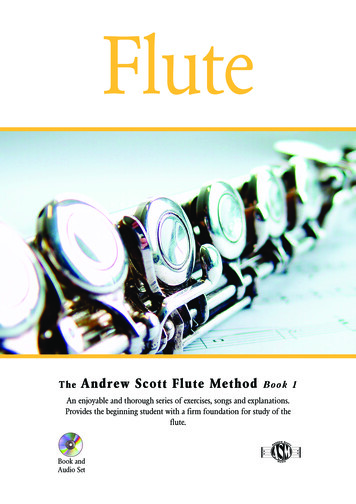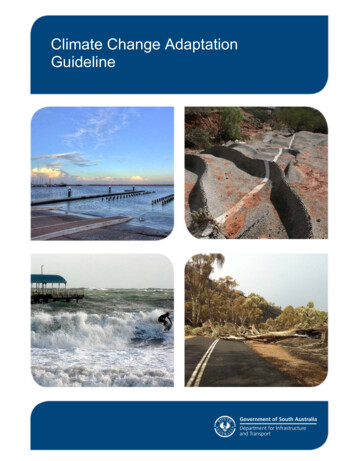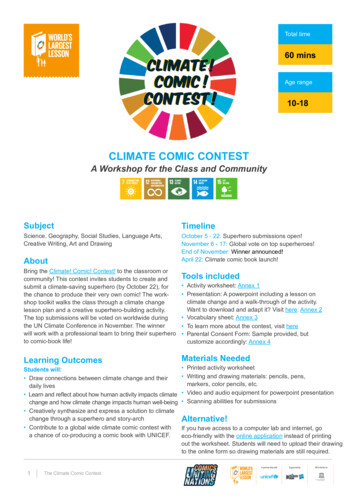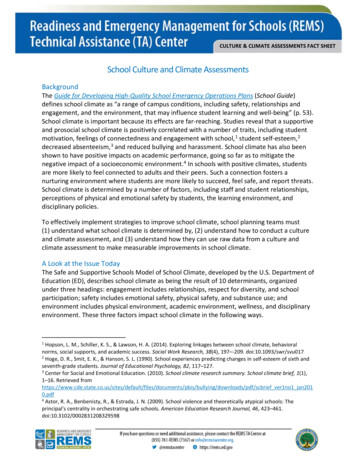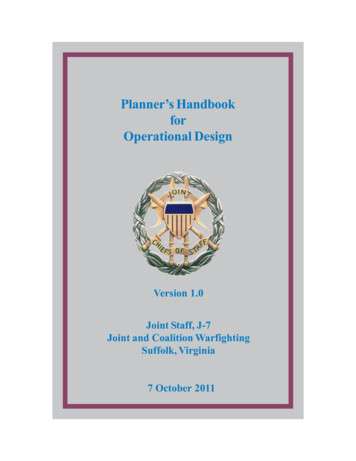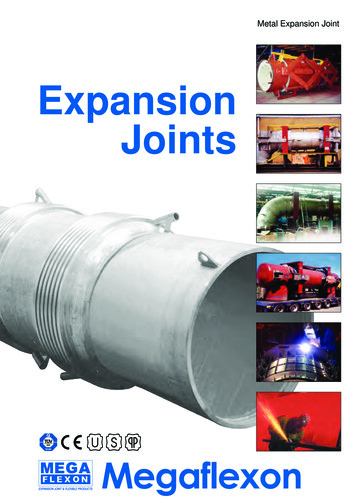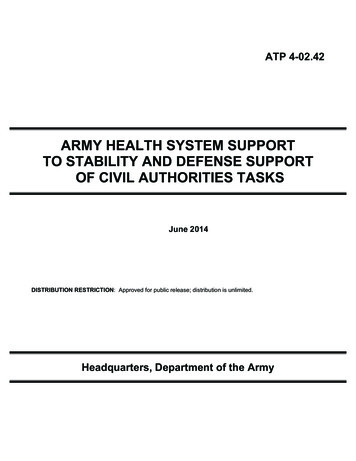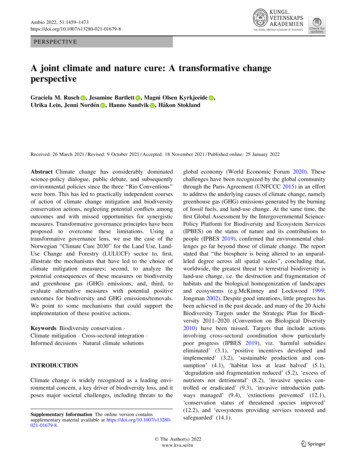
Transcription
Ambio 2022, 1679-8PERSPECTIVEA joint climate and nature cure: A transformative changeperspectiveGraciela M. Rusch , Jesamine Bartlett , Magni Olsen KyrkjeeideUlrika Lein, Jenni Nordén , Hanno Sandvik , Håkon Stokland,Received: 26 March 2021 / Revised: 9 October 2021 / Accepted: 18 November 2021 / Published online: 25 January 2022Abstract Climate change has considerably dominatedscience-policy dialogue, public debate, and subsequentlyenvironmental policies since the three ‘‘Rio Conventions’’were born. This has led to practically independent coursesof action of climate change mitigation and biodiversityconservation actions, neglecting potential conflicts amongoutcomes and with missed opportunities for synergisticmeasures. Transformative governance principles have beenproposed to overcome these limitations. Using atransformative governance lens, we use the case of theNorwegian ‘‘Climate Cure 2030’’ for the Land Use, LandUse Change and Forestry (LULUCF) sector to, first,illustrate the mechanisms that have led to the choice ofclimate mitigation measures; second, to analyze thepotential consequences of these measures on biodiversityand greenhouse gas (GHG) emissions; and, third, toevaluate alternative measures with potential positiveoutcomes for biodiversity and GHG emissions/removals.We point to some mechanisms that could support theimplementation of these positive actions.Keywords Biodiversity conservation Climate mitigation Cross-sectoral integration Informed decisions Natural climate solutionsINTRODUCTIONClimate change is widely recognized as a leading environmental concern, a key driver of biodiversity loss, and itposes major societal challenges, including threats to theSupplementary Information The online version containssupplementary material available at https://doi.org/10.1007/s13280021-01679-8.global economy (World Economic Forum 2020). Thesechallenges have been recognized by the global communitythrough the Paris Agreement (UNFCCC 2015) in an effortto address the underlying causes of climate change, namelygreenhouse gas (GHG) emissions generated by the burningof fossil fuels, and land-use change. At the same time, thefirst Global Assessment by the Intergovernmental SciencePolicy Platform for Biodiversity and Ecosystem Services(IPBES) on the status of nature and its contributions topeople (IPBES 2019), confirmed that environmental challenges go far beyond those of climate change. The reportstated that ‘‘the biosphere is being altered to an unparalleled degree across all spatial scales’’, concluding that,worldwide, the greatest threat to terrestrial biodiversity island-use change, i.e. the destruction and fragmentation ofhabitats and the biological homogenization of landscapesand ecosystems (e.g.McKinney and Lockwood 1999;Jongman 2002). Despite good intentions, little progress hasbeen achieved in the past decade, and many of the 20 AichiBiodiversity Targets under the Strategic Plan for Biodiversity 2011–2020 (Convention on Biological Diversity2010) have been missed. Targets that include actionsinvolving cross-sectoral coordination show particularlypoor progress (IPBES 2019), viz. ‘harmful subsidieseliminated’ (3.1), ‘positive incentives developed andimplemented’ (3.2), ‘sustainable production and consumption’ (4.1), ‘habitat loss at least halved’ (5.1),‘degradation and fragmentation reduced’ (5.2), ‘excess ofnutrients not detrimental’ (8.2), ‘invasive species controlled or eradicated’ (9.3), ‘invasive introduction pathways managed’ (9.4), ‘extinctions prevented’ (12.1),‘conservation status of threatened species improved’(12.2), and ‘ecosystems providing services restored andsafeguarded’ (14.1).Ó The Author(s) 2022www.kva.se/en123
1460Ambio 2022, 51:1459–1473It is not only species that are threatened, but also theecological functions that underpin multiple ecosystemservices. Since 1970, 14 of the 18 ecosystem servicesassessed in the Global Assessment have declined, includingair quality regulation, water purification, climate stabilization, control of natural hazards, pollination, and pestoutbreak control (IPBES 2019).Biodiversity and climate change in the globalenvironmental political agendaThe challenges to protect nature and manage ecosystemssustainably have been a political priority, at least sincethe United Nations Conference on Environment andDevelopment, in Rio de Janeiro 1992. Here, the three‘‘Rio Conventions’’ were born, i.e. the UN Convention onBiological Diversity (CBD), the UN Framework Convention on Climate Change (UNFCCC) and the UNConvention to Combat Desertification (UNCCD). It hasbeen the aim that the three conventions are intrinsicallylinked to develop synergies on issues of mutual concern(UNFCCC 2020). However, since its inception in 1994,the UNFCCC and its associated bodies and agreementshave considerably dominated the science–policy dialogueand the public debate about the state and severity of, andthe solutions to, global environmental challenges, to theextent that environmental challenges are often equated toclimate change problems. For example, the NorwegianEnvironment Agency states that: ‘‘Our primary tasks areto reduce greenhouse gas emissions, manage Norwegiannature and prevent pollution’’, indicating an urgency tostabilize the climate, but not in stopping biodiversity lossand the degradation of ecosystems and the services theygenerate.The great impact of the UNFCCC, both on the levelof concern and the actions needed to meet environmentalchallenges, has been attributed to the Convention following the line of the Montreal Protocol (on Substancesthat Deplete the Ozone Layer, 1987), which ‘‘bound themember states to act in the interests of human safetyeven in the face of scientific uncertainty’’ (UNFCCC2020). An even greater influence has been the establishment of the Intergovernmental Panel on ClimateChange (IPCC) in 1988, ‘‘to provide policymakers withregular scientific assessments on the current state ofknowledge about climate change’’ (IPCC 2020). Since itsfoundation, the IPCC has produced six assessmentreports at regular intervals, in addition to several thematic reports. The Nobel Peace Prize 2007 awarded tothe IPCC evidences the enormous importance of climatechange for society.123Two crucial and distinctive elements in the UNFCCCthat have further contributed to the relatively rapid takeup and implementation of climate actions, are that theincrease of atmospheric GHG can readily be attributed tohuman activities, and that it is possible to quantify theoutcomes of climate mitigation measures and policieswith a single index, the carbon dioxide equivalent (CO2e), providing a common and transparent metric to monitoranthropogenic GHG emissions and removals by thebiosphere.Twenty-four years after the establishment of IPCC,IPBES was founded in 2012 to form a scientific body,equivalent in its function to the IPCC, with the aim to‘‘strengthen the science-policy interface for biodiversityand ecosystem services for the conservation and sustainable use of biodiversity, long-term human well-being andsustainable development’’ (IPBES 2020).Addressing biodiversity and climate challengessimultaneouslyDespite the alarming trends presented in the GlobalAssessment (IPBES 2019), the report concludes that ‘‘nature can be conserved, restored and used sustainably whilesimultaneously meeting other global societal goals throughurgent and concerted efforts fostering transformativechanges’’ across economic, social, political and technological factors, and points out that these changes need toaddress individual and societal values and behaviors,technological innovations and governance. Visseren-Hamakers et al. (2021) highlight that the discussion about howto govern such changes is still in its infancy and argue thattransformative governance is needed to enable transformative change. They describe four transformative governance approaches that need to be implemented inconjunction to address sustainability issues: ‘‘integrative,to ensure local solutions also have sustainable impactselsewhere (across scales, places, issues and sectors); inclusive, to empower those whose interests are currentlynot being met and represent values embodying transformative change for sustainability; adaptive, enablinglearning, experimentation, and reflexivity, to cope withthe complexity of transformative change; and pluralist,recognizing different knowledge systems’’. Theseimproved forms of governance would imply better coordination and implementation of actions to address intrinsically related societal challenges such as climatemitigation, and the conservation and sustainable use ofbiodiversity.In this perspectives paper, we use Norway’s plan forcarbon mitigation measures, Climate Cure 2030 (Norwegian Environment Agency 2020), which we consider as aÓ The Author(s) 2022www.kva.se/en
Ambio 2022, 51:1459–14731461pre-IPBES, ‘business-as-usual’ approach to solving climatechange mitigation challenges, to illustrate current structuraland procedural limitations to the transformative governance approaches proposed in Visseren-Hamarkers et al.(2021). This case serves as an example of how climatemitigation actions are a hindrance to the protection ofbiodiversity when one does not follow transformativegovernance approaches.Following Visseren-Hamakers et al. (2021), we evaluatethe proposed actions in terms of how:(i)comprehensive knowledge from multiple sources isconsidered for decisions about climate mitigation andnature conservation (pluralist, through a revision ofthe knowledge base and its uptake in decisionmaking).(ii) plans and measures foster cross-sectoral synergiesand resolve conflicts between sectors that are detrimental for biodiversity and ecosystem services (integrative by showing how climate mitigation solutionsconsider possible synergies with biodiversity conservation and the generation of multiple ecosystemservices);(iii)value plurality and the due value of nature and itsservices are recognized when resolving trade-offs(inclusive, by illustrating how biodiversity conservation and ecosystem service priorities are incorporated in the climate action).We do not evaluate the proposed measures in ClimateCure 2030 in terms of the fourth approach, i.e. howadaptive the governance approach is, and whether decisions are made transparently and regularly reviewedbased on the best available knowledge and experience,but we bring in the ‘adaptive governance’ criteria, at asecond stage, when we formulate options for the future(i.e. tools for monitoring and reporting on the effects ofactions).At a second stage, we suggest how limitations could beturned into positive actions if transformative governanceapproaches would be followed.Our analysis first presents an overview of the knowledgebase, and how it informs the selection of climate mitigationmeasures under the ‘Land Use, Land-Use Change andForestry’ (LULUCF) sector. Second, we address how climate and biodiversity conservation and enhancementBOX 1 – NOT SEEING THE FOREST FOR THE TREES: THE NORWEGIAN CLIMATE CURE 2030Climate Cure 2030 proposes three key measures for the LULUCF sector.1. Increased density of trees in tree plantations. Dense plantations may present high risks for Norwegian forestryin the face of climate change1 and provide little habitat for forest biodiversity. Dense plantations are alsocharacterized by low cover of understorey vegetation, which contributes significantly to net carbon uptake2.2. Forest fertilization applied 8–10 years before final felling. Nitrogen fertilization encompasses risk forenvironmental pollution/eutrophication, reductions in plant and fungal diversity, changes in bacterial diversity,reduction in fungal biomass, and related changes in GHG emissions and carbon stocks3,4,5. Nitrogen fertilizationcan also increase the sensitivity of trees to drought and pest attacks by changing the level of chemical defence ofconifer needles6.3. Tree planting on non-forested land (afforestation). Can potentially have important negative effects onbiodiversity in the case of open semi-natural habitats, which are critical areas for the conservation of lightdemanding plant species and the organisms that use them. Grasslands, tree-less heathlands and wetlands have a veryhigh potential to store soil carbon (Fig. 1), which has been largely underestimated. Also, tree plantation in theseareas may not render the expected carbon removal level and could increase carbon loss and CO2 emissions7.1. Swedish forest agency 2020. Climate adaptation of forest and forestry – goals and proposed actions (in Swedish).2. Wardle et al. 2012. Linking vegetation change, carbon sequestration and biodiversity: insights from islandecosystems in a long-term natural experiment. J. Ecol. 100:16–30. 3 Zhang, T.A., et al. 2018. Global negative effectsof nitrogen deposition on soil microbes. ISME 12:1817–1825. 4. Zhou, Z., et al. 2017. Patterns and mechanisms ofresponses by soil microbial communities to nitrogen addition. Soil Biol. Biochem. 115: 433–441. 5. Midolo, G., et al.2019. Impacts of nitrogen addition on plant species richness and abundance: A global meta-analysis. Glob. Ecol.Biogeog. 28:398–413. 6. Nybakken, L., et al. 2018. Fertilization Changes Chemical Defense in Needles of MatureNorway Spruce (Picea abies). Front. Plant Sci. 9: 770. 7. Brown, I. 2020. Challenges in delivering climate changepolicy through land use targets for afforestation and peatland restoration. Env. Sci. Policy 107: 36–45.Ó The Author(s) 2022www.kva.se/en123
1462Ambio 2022, 51:1459–1473objectives are prioritized and harmonized within and acrosssectoral policies. Finally, we show the potential for newoptions that would embrace transformative governanceapproaches. We focus on LULUCF because of the potentially high level of conflict of climate mitigation actionswith nature conservation objectives (IPBES 2019). Thesetrade-offs, if not adequately addressed, will impair the jointachievement of multiple goals set under various multilateral agreements such as those under the CBD, theUNFCCC, the Gothenburg Protocol, and not least, theSustainable Development Goals (SDGs), including SDGs13 (Climate action), 14 (Life below water) and 15 (Life onLand).The Norwegian climate cure 2030After the Kyoto protocol entered into force in 2005, theNorwegian Government’s climate-related policy development gained momentum (Norwegian Ministry of theEnvironment 2007). Since then, and following commitments with the Paris Agreement under the UNFCCC, theNorwegian Government has proposed a plan for theLULUCF consisting in three key measures (Box 1), called‘Climate Cure 2030’ (Norwegian Environment Agency2020). The goal of Climate Cure 2030 is to increase theremovals of atmospheric carbon by managed ecosystems(land-uses and forestry).THE KNOWLEDGE BASE FOR PLURALISTDECISION-MAKING—THE CASE OF STANDINGSTOCK VS. ECOSYSTEM-WIDE MANAGEMENTOF CARBON STOCKSPluralist governance requires a transformation in howsocieties value nature and its contributions. This builds onthe increasing awareness of the importance of how evidence is collected and understood in informing and shapingdecision-making (Jacobs et al. 2018).Carbon accounting, i.e. how much and where carbonemissions and removals occur, is central to identifyingmeasures to mitigate climate change. Due to the difficultyin providing widely applicable and scientifically robustmethods to assess land-based GHG fluxes, the IPCCGuidelines have adopted a pragmatic approach, and GHGuptake in and emissions from ‘‘unmanaged land’’ are notreported in GHG inventories because they are assumed tobe non-anthropogenic. Further, national GHG inventoriesrely on chosen methods of estimation and nationalaccounting rules, which differ in approach and complexityamong countries (Grassi et al. 2018).123Globally, all marine and terrestrial ecosystems are sinksfor anthropogenic carbon emissions, with a gross sequestration of 5.6 Gt C year-1 (1 Gt 1 gigaton 1012 kg), theequivalent of some 60% of global anthropogenic CO2emissions (IPBES 2019). Terrestrial plants and soils currently absorb approximately 33% of anthropogenic CO2emissions, yet this is partially offset by emissions related tothe land-use change (ca 10%) (Le Quéré et al. 2014). Interrestrial systems, up to 80% of the carbon (2500 Gt C) isfound in soils, whereas the amount of carbon in livingplants and animals is comparatively small (560 Gt C; Ontland Schulte 2012; see Villa and Bernal 2018), highlightingthe importance of functioning ecosystems for removingcarbon from, and preventing release to, the atmosphere.Norwegian ecosystems contain approximately 0.18% ofall global carbon stocks, with a land mass that is 0.07% ofthat of the planet (Bartlett et al. 2020). This high carbon-toarea ratio is likely due to the large proportion of thecountry that is carbon-rich peatlands (alpine and lowland)and boreal forest. The largest stores of carbon are in foresthabitats (32%) which also cover 38% of the total land area.Wetlands and permafrost-covered ecosystems, 9% and 3%of the total land mass, respectively (Bryn et al. 2018), storeover 2.2 Gt C, 34% of the nation’s carbon (Fig. 1; Table 1).These two ecosystems are the most carbon dense terrestrialecosystems, with an estimated 50 and 58 kg C m-2 forwetlands and permafrost, respectively. Similar carbonstores can be found in freshwater lake sediments, also with50 kg C m-2, amounting to 14% of all carbon storage.Regarding the removal rate of atmospheric CO2, forestsand low-mid alpine zones are estimated to take up the mostcarbon on an annual basis (5.5 and 5.3 Mt C year-1,respectively; 1 Mt 1 megaton 109 kg), with soils inalpine heathlands contributing the most to alpine carbonstores.NOT SEEING THE WOODS FOR THE TREE—ASKEWED KNOWLEDGE BASE FOR CARBONACCOUNTS IN LULUCFDespite the apparent simplicity of applying CO2-e as auniversal metric of emissions and removals of atmosphericGHG, an accurate assessment of these values and how theyare modified by ecosystem management is difficult,because it entails a systemic approach and the understanding of complex ecological processes. The fact thatthere are significant mismatches between measured atmospheric GHG concentrations and reported emissions andremovals (Peters et al. 2017) indicates that there are considerable uncertainties and potential biases in the carbonremoval assessments and reporting (Table 1).Ó The Author(s) 2022www.kva.se/en
Ambio 2022, 51:1459–14731463Fig. 1 a Norwegian ecosystem carbon storage density (kg C m-2), shown with its constituent elements: b the area proportion (%) ofecosystem/land cover types; and c carbon storage estimates for each ecosystem, excluding ‘built-up’ and ‘bare rock’ area types, which do nothave such data available. For communication purposes, lowland grasslands and cultivated land (crops) are color grouped, as are both ‘coastal’and ‘other’ heathland types. All data and sources are detailed in Table S1Current carbon-removal and -emission accounts in theNorwegian LULUCF sector are based on data from anextended National Forest Inventory (NFI) program, whichare skewed in terms of how different ecosystems’ carbonstocks are valued, which elements of the terrestrial carbonbudget are considered, and how they are estimated. TheIPCC LULUCF classes are forest, cropland, grassland,wetlands, settlements and other land. ‘Other land’ (4F) isdefined in the NFI ‘‘as waste land, such as bare rocks, ice,and shallow soils that may have particularly unfavorableclimatic conditions’’. In accordance with the IPCC definition, other land can also include unmanaged land areas thatdo not fall into any of the other five land-use categories, forexample, heathland, other wooded land (i.e. land withsparse tree cover on mineral soil), and open areas (Norwegian Environment Agency et al. 2020). Coastal andfreshwater ecosystems are not assessed.In addition, the extent and accuracy of ecosystemmapping and carbon budget assessment varies. In the caseof forest, an ecosystem type that covers ca 38% of the landsurface (Fig. 1), the NFI (Breidenbach et al. 2020) providessystematic accounts of the standing stocks of living trees.The inventories are skewed geographically, with lowerdensity of inventory plots in areas with alpine characteristics, yet these data are the basis of calculating carbonstored in living tree biomass in Norway. For soil anddeadwood carbon estimates, the Yasso07 model is used(Liski et al. 2005), parameterized with Norwegian datacollected in 1988–92 (de Wit and Kvindesland 1999;Grønlund et al. 2010), and partly with data from elsewhere(de Wit et al. 2006; Dalsgaard et al. 2016). The accountingdoes not include small trees, shrubs or any other understorey vegetation. Neither does it include the variation insoil biomass, yet Norwegian forest soils hold 3–4 timesÓ The Author(s) 2022www.kva.se/en123
1464Ambio 2022, 51:1459–1473Table 1 Carbon storage in Norwegian ecosystemsEcosystemC storageIn Mt CForestsConfidenceIn %EvidenceAccountingEffect of land-use ing tedHighNot e80012LimitedMediumIf convertedIntermediateWetlands140022LimitedMediumIf LimitedMediumLowNot includedIf convertedLowLowOpen matedHighHeathland1002LimitedLowIf convertedIntermediateCoastal8\1MediumMediumNot edHighCroplandConfidence in the carbon storage estimates is divided into type, amount and quality of evidence, and degrees of agreement. Accounting indicateswhether and how this (sub)ecosystem is covered by the national LULUCF accounting system (either measured directly; estimated based onsimplifying assumptions; calculated only for areas that are converted to or from an ecosystem type that is measured or estimated; or not includedat all). Effect on land-use change refers to the effect that land-use changes may have on the ecosystem’s capacity to take up and store carbon. Theunderlying data and sources are provided in the Supplementary Informationmore carbon than the biomass of the forest trees (Søgaardet al. 2019). Dead wood represents a carbon dense organicmatter, most of which currently occurs in forest reserves,which cover only 5% of the forest area in Norway (Norwegian Environment Agency et al. 2019). Despite theforest carbon budget being strongly affected by forestrypractices, their impacts on emissions and uptake are notproperly accounted for, since a significant part of the relevant carbon stocks and the processes affecting them arenot incorporated in the accounting.Most wetland areas, excluding those used for peatextraction and flooded lands caused by human constructeddams, are considered unmanaged, and therefore not included in the UNFCCC reports (Grassi et al. 2018). For allland categories—forests, cropland, grassland, wetlands,settlement, other land—carbon accounts are reported basedon estimated emissions and removals following change inland use between categories. The changes are based on arearepresentative statistics collected as part of the NFImethodology (Norwegian Environment Agency et al.2020).The LULUCF category ‘‘other land’’ covers approximately 45% of the total land area in Norway. Much of thisis alpine and cryosphere ecosystems that contribute withapproximately 13% and 12%, respectively, to the carbonstocks in Norway (Table 1; Fig. 1). However, they areroughly considered as one homogeneous ecosystem, usingpooled and coarsely estimated data of carbon stocks and123fluxes (Norwegian Environment Agency et al. 2020). Thelarge variety of ecosystems and habitat types within the‘alpine’ zones results in varied primary production, carbonsequestration and storage levels, that reflect a highlyheterogeneous area of land, and one that is particularlyvulnerable to climate change, management practices, andland-use conversion (Strimbeck et al. 2019; Bartlett et al.2020). These accounting conditions may critically misguide climate mitigation measures proposed for theLULUCF sector.Despite soil holding the highest carbon stocks in borealforest (Scharlemann et al. 2014; Søgaard et al. 2019), thehigh costs of measuring soil carbon stocks, uptake andemissions have made it challenging to include forest soildegradation on emissions accounts, thereby also excludingforest soil protection and restoration as an eligibleecosystem component for climate mitigation actions (vonUnger and Emmer 2018). Further, the requirement ofadditionality of climate mitigation actions (i.e. quantitativeattribution of carbon removals to specific climate actionsunder the Clean Development Mechanism, UNFCCC1998), has led to high reliance and trust on data such aschanges in the standing stocks of living trees. While thestanding stock of living trees is a convenient statistic, it isnot a representative measure for a whole ecosystem.Of the carbon stocks reported by the official Norwegianaccounting system of the LULUCF sector, 90% are basedon rough estimates with unknown precision (Table 1).Ó The Author(s) 2022www.kva.se/en
Ambio 2022, 51:1459–14731465CROSS-SECTORAL INTEGRATION OF CLIMATEMEASURES ON BIODIVERSITY—THE CASEOF FOREST FERTILIZATIONForest fertilization is one of the key measures proposed inClimate Cure 2030, meaning that knowledge of nitrogenfertilization’s influence on ecosystem GHG fluxes is nowcrucial for climate action. However, the long-term consequences of fertilizer use on soil communities, that in turninfluence nutrient cycling, soil productive capacity, andGHG emissions (Li et al. 2019), are insufficiently known,especially in interaction with the effects of climate change(Coucheney et al. 2013). Simultaneously, excess nitrogenitself is a major global environmental challenge, causingsignificant biodiversity and ecosystem-service loss both interrestrial and aquatic systems (Rockström et al. 2009).Although there have been important efforts to reduce theapplication of mineral fertilizers in many countries (e.g. inthe EU), targets to reduce the amount of nitrogen fertilizerin nature have not been achieved (i.e. poor achievement ofAichi target 8.2, ‘‘Excess nutrients not detrimental (tonature)’’, IPBES 2019). In Norway, disputed evidence onthe effects of nitrogen fertilization in forests have beensummarized to inform Climate Cure 2030 measures(Box 5; Fig. 3, Aarrestad et al. 2013; Haugland et al. 2014).With the goal of enhancing atmospheric carbon removals(to compensate for emissions) by15–17 Mt CO2-e by theyear 2020, forest fertilization was singled out as a promisingclimate mitigation action for the LULUCF sector in Norway.It was estimated that annual forest fertilization of 120 km2would increase carbon removals by 0.4 Mt over a period of10 years (Norwegian Ministry of Agriculture and Food2009). The first national climate change mitigation program,Climate Cure 2020 (Norwegian Climate and PollutionAgency 2010), recommended fertilization for increasing treebiomass based on these calculations. Initially, there waspotential for an integrative governance process: The politicalbacking of using forest fertilization as a climate changemitigation measure was reinforced by a 2012 white papersupported by the Norwegian parliament, while acknowledging that environmental criteria had to be developed(Norwegian Ministry of the Environment 2012, p. 159).Marginalization of the value of natureand biodiversityTwo reports reviewing the evidence on the effects ofnitrogen fertilization on biodiversity (Aarrestad et al. 2013;Haugland et al. 2014) were commissioned to help implement an environmentally friendly climate policy, suggesting an integrative and pluralist approach. Aarrestad et al.(2013) warned against the use of forest fertilizationbecause of the questionable climate effect, considering allGHGs and the high likelihood of very negative effects onbiodiversity above and below ground. In contrast, a reportpublished by a broad group of environmental and forestryagencies (Haugland et al. 2014) concluded that the effectson biodiversity would be acceptable, despite citing Aarrestad et al. (2013). The conclusion was based on severalassumptions, the main postulate being that fertilizationwould be used in areas where logging was already planned,and that the effects of fertilization on the individual foreststand would be small compared to the effects of logging(Haugland et al. 2014). The potential effects of fertilizationon soil carbon dynamics, as well as the potential forincreased N2O emissions, were recognized in the report,but left out of the calculations because of uncertaintyregarding the exact effects. Hence, regardless of the concerns raised in Aarrestad et al. (2013), Haugland et al.(2014) and later reports (Hanssen and Bergsaker2017) concluded that the effects of fertilization on terrestrial ecosystems were acceptable, and the net climate effectwas evaluated to be positive (Fig. 2).In the political processes on matters concerning forestfertilization, Haugland et al. (2014) were granted authorityover Aarrestad et al. (2013) (Fig. 2). This is perhaps notsurprising, as the former had the mandate to conduct across-sectoral and integrated review of knowledge andpolicy options. However, its conclusions established themarginalization of biodiversity and soil carbon as the normin the following governance processes related to forestfertilization. The report by Haugland et al. (2014) was alsothe basis for the establishment of climate mitigation subsidies for forest fertilization in 2016, and the only reportreferenced in the national budget that granted the funding(Norwegian Ministry of Food and Agriculture 2015). Thesubsidies led to more than a tenfold increase in fertilization; the net amount of nitrogen applied to forest land wentfrom
Assessment (IPBES 2019), the report concludes that ‘‘na-ture can be conserved, restored and used sustainably while simultaneously meeting other global societal goals through urgent and concerted efforts fostering transformative changes’’ across economic, social, political and techno-l



